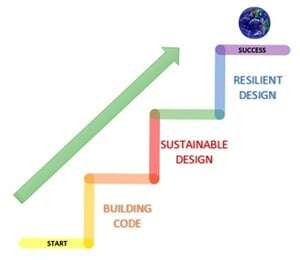It is hard to believe that sustainability has been the focus of innovative designs for nearly 22 years*. The run has been fulfilling and demanding, but it has me thinking what’s the next challenge or the new hurdle to overcome.
Sustainable designs embody several concepts, some of which are resource management through consumption reduction, improving resource utilization and lowering environmental impact by locally sourcing material. A simple definition of sustainability is reducing negative effects of buildings on the occupants and environment. Meeting building code requirements is the first step to developing safe buildings. Think of sustainable design as the second step on the stairway - developing occupant and environmentally responsible buildings.
Understanding that climate change occurs naturally compels a comprehension of how the climate is changing. Extensive analysis of past climate data has been conducted and the results show that human contributions to climate change have drastically increased its rate**.

Now we must ask ourselves, how best to plan for those changes, which leads us to resilient design. Planning for changing climates environmentally, culturally and otherwise is at the heart of resilient design. Resilient design is the third step in successful building design, extending the useful life and functionality of a building. Reaching the top of the stairs means you have a safe, sustainable and resilient building.
Resilient design can be lumped into two categories, the first being typical climate conditions and the second is accelerated climate conditions. Examples of typical climate conditions are earthquakes in California or flooding in New Orleans. Accelerated climate conditions are global sea level rise, super storm Sandy and the current California drought.
Resilient design is not a new concept. We have a long-standing history of designing mission critical facilities that implement resiliency into design. Our clients build in locations with threats ranging the spectrum, which commonly requires resilient fortification, energy and water resources.
By now, most of you have heard stirrings related to resilient design, but what does resilient design mean and how does one achieve it?
“Resilience is the capacity to adapt to changing conditions and to maintain or regain functionality and vitality in the face of stress or disturbance. It is the capacity to bounce back after a disturbance or interruption of some sort.” - Resilient Design Institute
Resilience is keenly focused on three concepts: 1) adaptability, 2) functionality, and 3) vitality. These concepts are linked and all three are necessary to balance the equation.
Adaptability is the act of adjusting, which in a building or system design can be as simple as increasing the thermostat or as complex as changing ventilation airflow based on the number of occupants. Functionality relates to capability of operation; displayed best in the continuation of system operation despite equipment failure, power and water outages. Vitality, or the capacity for survival, encompasses the need to design for food shortages, severe storms, natural disasters, and power and water outages.
Techniques incorporated in resilient designs include:
- - Redundant energy and water sources through on-site production or capture (i.e. – generators, solar PV, solar thermal, water purification, wastewater treatment)
- - Site sourced food production (i.e. – orchards, gardens, green roofs)
- - Improved building integrity (i.e. – seismic isolation, hurricane proof shutters, reduced infiltration, increased insulation)
- - Site and building location (i.e. – above flood plain, historical and projected climate conditions)
Can a sustainable design be a resilient design, and are the two compatible? The answer is yes! In fact, sustainability can be instrumental in achieving resilience.

Sustainable designs assist in achieving resilient designs. The US Green Building Council’s LEED accreditation is an industry standard for sustainable designs. An example of sustainability assisting resilient design is shown in the LEED Optimize Energy Performance Credit. This credit requires minimum energy reductions that exceed typical building code standards. The reduction in energy consumption through things such as improved designs and equipment efficiency reduces the annual energy and typical peak building loads. Energy reductions enable a more cost effective and constructible approach to resiliency, by reducing the system size for site generated power (i.e. – generators, wind turbines, solar PV).
The LEED Water Efficiency category focuses on reductions in water consumption. Sustainable designs utilizing recycled/reclaimed water or rainwater harvesting to serve as alternate water sources and can lead to NetZero water designs. Designs incorporating alternate water sources or self-sustaining water use empower water independence, a component of resilient designs.
Sustainable and resilient designs are interwoven, creating the fabric to support future generations.
* U.S. Green Building Council was established in 1993.
** 2014 National Climate Assessment - Climate Change Impacts in the United States (nca2014.globalchange.gov)

